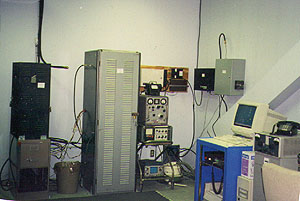 You will not hear a courtesy beep if:
You will not hear a courtesy beep if:
The main repeaters for Hospital Disaster Support Communications System (HDSCS) were K6QEH/R on 146.970(-) MHz, PL 136.5 Hz and 446.44 MHz(-) PL 114.8 Hz. They were the first repeaters for HDSCS members to check/monitor when a widespread communications emergency occured. This page gives some background and useful operating tips regarding these repeaters.

K6QEH/R (then WR6ACQ) was the first "aerospace industry" ham repeater in southern California. Designed and built "from the ground up" by the Hughes-Fullerton Employee Association (HFEA) Amateur Radio Club, it went on the air in 1973 on 146.880(-) MHz atop Building 606 of the company's facility near the Fullerton Airport. The frequency pair was changed to 146.970(-) in December 1979 due to unresolvable co-channel interference problems. An autopatch was added in September 1981 and an auxiliary receiver at 1000-foot elevation in La Habra Heights went into service July 1983.
Upon closure of Building 606 in 1994, the repeater was relocated to a new radio room in the penthouse of Building 675 and new towers were installed atop that building to support the repeater antennas. In December 1997, this facility and its employees became part of the newly-merged Raytheon Electronic Systems. Employees and retirees of Raytheon (now RTX Corporation) continue to administer and maintain it.
A closed K6QEH repeater on 446.44(-) MHz went into operation in the penthouse in 1998. It is now an open repeater and is full-time linked to the two-meter repeater.
The penthouse radio room is powered from the building's automatic emergency generator. There is also a battery backup system. If both commercial and generator AC power fail at the radio room, transmitter power will be automatically reduced by approximately 6 dB. As an indication, the CW ID tone (not the courtesy beep) will change from high pitch to low pitch.
The two-meter remote receiver's tower in La Habra Heights failed in a windstorm in 2023. Both VHF and UHF repeaters continue single-site operation in Fullerton.
K6QEH/R shares its two-meter frequency pair with low-level repeaters in Oxnard, Santa Clarita, Vista, Trona and Barstow. We have an excellent relationship with the other 146.970 repeater owners/users and we want to keep it that way. You can help by not using high power (more than 50 watts) or large base station antennas to work through our repeater when you are in a location where you might put a strong signal into one of the other machines.
These repeaters are now used regularly by members of the Fullerton Radio Club. The club holds a net on Wednesays at 6:30 PM local time.
The K6QEH/R repeaters are "open." All well-mannered conversations are welcome. The autopatch is no longer available for security reasons.
There is a courtesy beep when a user unkeys and the timer resets. Another transmission can begin during the following "hang time" before the repeater carrier drops.
 You will not hear a courtesy beep if:
You will not hear a courtesy beep if:
The repeater timeout period is 90 seconds. If you time out, the repeater will transmit a long "BZZZZZZ" (the razz-berries!) when you unkey and the timer resets.
Key-up of the repeater is slowed slightly by response time of the CTCSS decoder and voting system. When using this repeater, remember to hesitate a half second to a second after pressing your PTT before beginning to speak. If you start talking too soon, the decoder may not engage for an even longer period and your first words won't be heard.
The two-meter receiver has very steep bandpass characteristics and an off-frequency lockout circuit to prevent interference from a repeater that is 15 KHz above our pair. Your signal must be on frequency and deviate less than 5 KHz peak to be properly retransmitted through K6QEH/R. If someone tells you that your signal is distorted or "cutting out," check your 5 KHz switch (i.e. verify you are tuned to 146.970 and not 146.975). If frequency is correct and the problem persists, back off from your mike and talk more softly.
Don't expect "hi-fi" audio through this or any other well-engineered repeater. Low frequencies are deliberately rolled off to filter out subaudible tones. High frequencies are restricted as a courtesy to prevent QRM to adjacent channel repeaters. Intelligibility is still very good, despite these restrictions, if you keep your deviation at the proper level.
One last request: It is club policy to not talk on the air about the upcoming or ongoing out-of-town trips of other hams, to protect their property and families. There are a lot of listeners out there!
For more information on the repeater, contact Joe Moell KØOV, Repeater Technical Advisor.
In the photos: Original La Habra Heights tower above left, part of K6QEH radio room above right, Fullerton site antennas below.


Read a company newspaper article about the sign-on of the two-meter repeater in 1973
Or go back to the HDSCS home page
This page updated 2 June 2025